Almost a decade after Indonesia passed a law on waste management, the country still faces the extremely pressing problem of electronic waste. The Jakarta Post’s Corry Elyda examines why the government remains powerless.
As a developing country with a burgeoning middle class population, Indonesia has become one of the world’s largest markets for electronics. According to the latest survey from the Indonesian Internet Providers Association (APJII), almost 133 million Indonesians had access to the internet last year through their smartphones and computers.
The people’s thirst for latest gadgetry models means they would replace their cellular phones every 18 – 24 months or so. If you ever wondered where the scrapped mobile phones, PCs, tablets, TV sets and home appliances could possibly end up, you may well be surprised: The old electronics have nowhere to go to die.
According to the 2015 Global e-waste report released by the United Nations University, Indonesia’s mountain of electronic waste was the highest in all of Southeast Asia at 812 kilotons. Vietnam’s was the second highest at 451 kilotons, followed by Malaysia’s 243 kilotons.
E-waste consists of practically all electrical equipment that has been discarded, from mobile phones to computers, to batteries, printed circuit boards, battery chargers, monitors and to modems, as well as home appliances from music players to light bulbs.
Unable to control ownership of electronics, Indonesia remains clueless in how to treat its omnipresent e-waste. At the typical urban house, you can see broken TV sets, radios, light bulbs and refrigerators stacked in one corner, or worse, at the neighborhood communal dump.
Many reuse their old devices, albeit improperly. Villagers place their leaking dry cell batteries on their rooftops in the sun, believing that doing so would prolong their lifespan. An irreparable washing machine might be used as a table, and a broken fridge as a shoe rack. No joke.
 It is on: A screen and a mirror show the layout of a junk mall in Depok, West Java. (JP/Seto Wardhana)
It is on: A screen and a mirror show the layout of a junk mall in Depok, West Java. (JP/Seto Wardhana)
Sometimes, they sell their old, broken devices to the scavengers who occasionally visit and buy people’s junked electronics at terribly low prices; still, they would regard this as better than throwing them away. And then, they don’t care where the high-tech trash goes when it leaves home. They rightly assume that the junked electronics ends up at landfills.
People are generally aware that their devices contain poisonous chemicals and heavy metals that pose health hazards, but think it would be all right as long as the electronics are not disassembled carelessly.
Electronic waste contains hazardous elements, including heavy metals such as mercury, lead, chromium, cadmium, arsenic, silver, cobalt, palladium and copper. According to the World Health Organization (WHO), exposure to even low levels of mercury, cadmium and lead can cause serious neurological damage and impair a child’s physical and mental development. The substances used in a cell phone are especially dangerous for children and pregnant women.
Mercury is also injected into compact fluorescent light bulbs. Although each light bulb usually only contains around 4 milligrams, exposure to the substance can lead to grave health problems. The WHO warns that mercury adversely affects the nervous, digestive and immune systems, as well as the lungs, kidneys, eyes and skin.
Arsenic is also widely used in the electronics industry for manufacturing transistors, semiconductors, glasses, textiles, ceramic, glue and explosives. The element can cause metabolic problems in humans and animals, resulting in poisoning and even death. Many minerals used in electronics are also carcinogenic.
People’s ignorance of how to treat their e-waste properly is not the sole cause of concern. Every year, every Indonesian produces up to 3 kilograms of such waste. The government is in a position to blame for having no plan as what to do with the dangerous high-tech garbage.
Perhaps only a few people are aware that Indonesia has Law No. 18/2008 on waste management, but the law is unenforceable because the government is yet to make specific regulations. It looks as though Indonesia has been in hibernation throughout the past decade as e-waste grew increasingly as a threat to public health and the environment.
The Environment and Forestry Ministry’s waste management director, Sudirman, claims that the much-awaited government regulation is halfway ready.
“We have to take care of many issues, but we’re making progress. It is already 60 percent complete,” he said when asked why it took the ministry such a long time to create the regulation.
Under future legislation, e-waste will be treated as “specific waste”. Unlike conventional household waste, e-waste will receive special treatment because of its highly toxic nature. The regulation will require the government to provide the necessary infrastructure and supporting facilities for its management and disposal. “We will pick one city for a pilot project,” said Sudirman.
Among the policy options the government is weighing is the extended producer responsibility (EPR) scheme, which has been implemented in countries grouped in the Organization for Economic Cooperation and Development (OECD). Under this approach, producers are required to share the responsibilities for the treatment or disposal of post-consumer electronic products.
Japan, for example, obliges electronics makers to set up their own recycling facilities or commission a third party to recycle their products. The European Union has shifted the burden of safe e-waste disposal back to the manufacturers, and electronics sellers are required to accept customer' old products free of charge for recycling.
In Indonesia, the EPR model is stated in the waste management law but it faces a formidable challenge from manufacturers. Interestingly, although the law makes it obligatory for manufacturing companies to recycle their used products, the government doubts the regulation would be effective.
Although the waste management law makes it obligatory for companies to take back their post-consumer products, government officials have backtracked and made it voluntary instead.
Sudirman says frankly that requiring manufacturers to take back their old products was easier said than done, given the fierce objections from not only businesses, but also the Industry Ministry.
"In practice, shifting the responsibility for the safe disposal of used goods to manufacturers is not obligatory, but voluntary," he says. “We need to be careful [in its implementation], so it will not harm the industry.”
 Mighty waste: A man visits a junk mall in Depok, West Java, to buy electronic parts. (JP/Seto Wardhana)
Mighty waste: A man visits a junk mall in Depok, West Java, to buy electronic parts. (JP/Seto Wardhana)
From the manufacturing industry’s side, its reserve is voiced by the chairman of the electronics companies association, Ali Soebroto. Basically, the businesses claim they have no objections to the EPR scheme, but they are calling on the government to design workable procedures before putting it in place.
"[The government] requires us to shoulder the waste management cost in advance, before we collect the old products from consumers. This can disturb our cash flow as there is no guarantee that we can sell our entire stock of electronic devices whereas we had paid for the waste management cost," says Ali.
Instead, the association suggests that the responsibility for the waste disposal costs is given to consumers so as not to financially burden the manufacturers. So far, electronics makers have facilitated the process with trade-in schemes, under which consumers bring in their old devices in exchange for discounts on purchasing new products. But, as the association reports, this option is unsustainable because the manufacturers cannot always recover the resulting losses.
 Amid the junk: A daily spectacle at a junk mall in Depok, West Java. (JP/Seto Wardhana)
Amid the junk: A daily spectacle at a junk mall in Depok, West Java. (JP/Seto Wardhana)
For environmentalists like the Indonesian Center for Environmental Law (ICEL), the EPR serves as the most ideal model.
"Companies can reuse the components and make a lucrative business," says ICEL researcher Margaretha Aquina.
That can happen only if the government moves swiftly in making good regulations and enforcing them. When it comes to the safe disposal of e-waste, Indonesia lags way behind other countries, especially those that have ratified the Basel Convention – an international accord that makes it illegal to export or traffic in e-waste.
While the central government remains sluggish in drafting toxic waste management regulations, the Jakarta administration is attempting a breakthrough. To start with, it embarked on a proper e-waste disposal campaign this January and set up drop boxes in designated areas while the ordinance was being developed.
 Above and beyond: A man looks for electronic parts at a junk mall in Depok, West Java.(JP/Seto Wardhana)
Above and beyond: A man looks for electronic parts at a junk mall in Depok, West Java.(JP/Seto Wardhana)
Drop boxes have been placed next to the city environmental agency’s information booths on Jl. Sudirman and Jl. Thamrin in Central Jakarta which are operational during the car-free Sundays, and at the agency's headquarters in Cililitan in East Jakarta that open on weekdays.
"Residents can actually drop their e-waste at the district or subdistrict offices. All they have to do is find our staff and give it to them," says the agency's Dangerous and Hazardous Waste Department head, Rosa Ambarsari.
While the legal basis is yet to be drafted, the Jakarta administration is also yet to allocate a budget for the experimental program. Besides, the number of drop boxes remains extremely limited. Still, public response so far has been relatively encouraging. This year, the agency has collected 600 old mobile phones and other scrapped electronic devices.
For recycling, the agency has joined hands with private waste management company PT Prasadha Pamuna Limbah Indonesia.
"Unfortunately, the company only takes old mobile phones,” Rosa says. At the agency’s headquarters in East Jakarta, scrapped electronics like computers, electric fans and light bulbs are piling up.
There are several companies in the country that recycle toxic waste, but they mainly serve private clients.
Because people have the option of reselling their dead cell phones and other electronic devices to scavengers, they are usually reluctant to put them in the drop boxes provided by the city’s environmental agency. "These dead devices still have economic value, no matter how little," Rosa says.
Scavengers usually sell the broken devices to other parties that will extract the valuable minerals like gold and silver – a relatively new profession called “urban mining”. These urban miners pose another environmental menace: They throw away the remaining e-waste irresponsibly.
"The gold and silver are sold on the black market," says Ahmad Syafruddin of the Community for Leaded Gasoline Eradication (KPBB), who has been educating urban miners in Greater Jakarta for years.
As the state remains oblivious about what to do with the kilotons of e-waste, millions of our old electronics have nowhere to go to die a proper death, and they are certainly not resting in peace.
 Hanging low: Visitors browse electronic parts at a junk mall in Depok, West Java. The volume of discarded electronics in East and Southeast Asia jumped 63 percent between 2010 and 2015, totaling 12.3 million tons. Meanwhile, each person in Indonesia dumps around 3 kilograms of electronic waste every year. (JP/Seto Wardhana)
Hanging low: Visitors browse electronic parts at a junk mall in Depok, West Java. The volume of discarded electronics in East and Southeast Asia jumped 63 percent between 2010 and 2015, totaling 12.3 million tons. Meanwhile, each person in Indonesia dumps around 3 kilograms of electronic waste every year. (JP/Seto Wardhana)
Naïve urban miners risk own, neighbors’ lives for peanuts
From the outside, there is nothing to suggest that the modest building tucked into a crowded neighborhood in Tangerang, Banten, is a workshop full of […] high-tech electronic junk.
Inside the roughly 8-meter by 5-meter property that is confined to concrete walls and connected to a busy road through a bamboo gate, its owner, Musa, is busy disassembling scrapped electronics of all sorts. The 46-year-old appears relaxed, donning no protective gear like typical workers at modern electronic workshops. A pair of sandals is all that protects his feet from harm while he moves across the house’s dirt floor. No coveralls, no goggles, no gloves.
Even though he has his hands on state-of-the-art technology, he does everything on his own most of the time, using no sophisticated tools or equipment. Strewn on the floor is everything from dead TV sets to printed circuit boards (PCBs), from personal computers to spent cartridges.
Some of his tools are a clay wok, plastic buckets and a welder – all placed close to a sack of highly flammable caustic soda. Greenish liquid waste is stored inside an uncovered plastic bucket near the entrance gate, within the reach of the many children passing by.
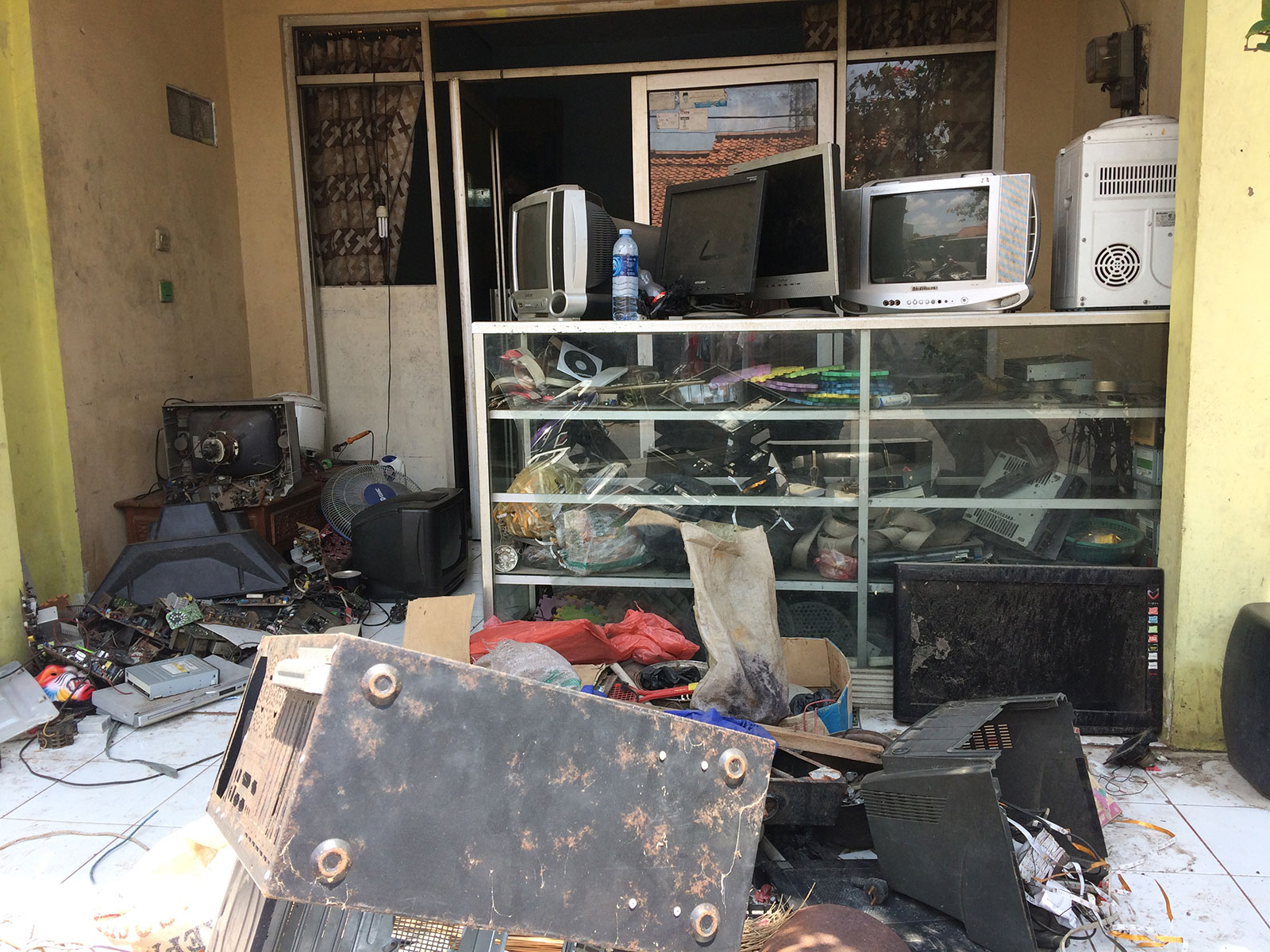
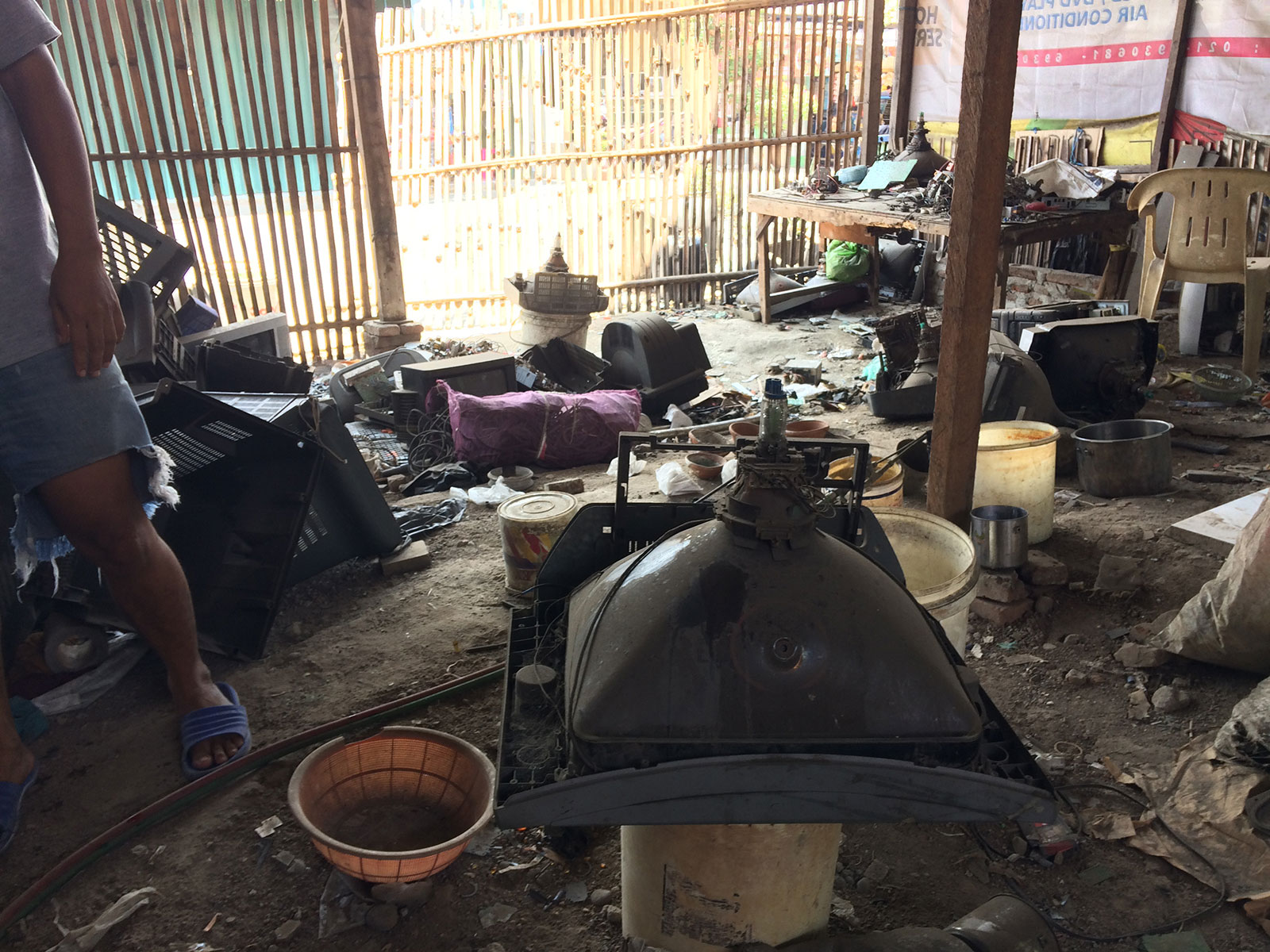
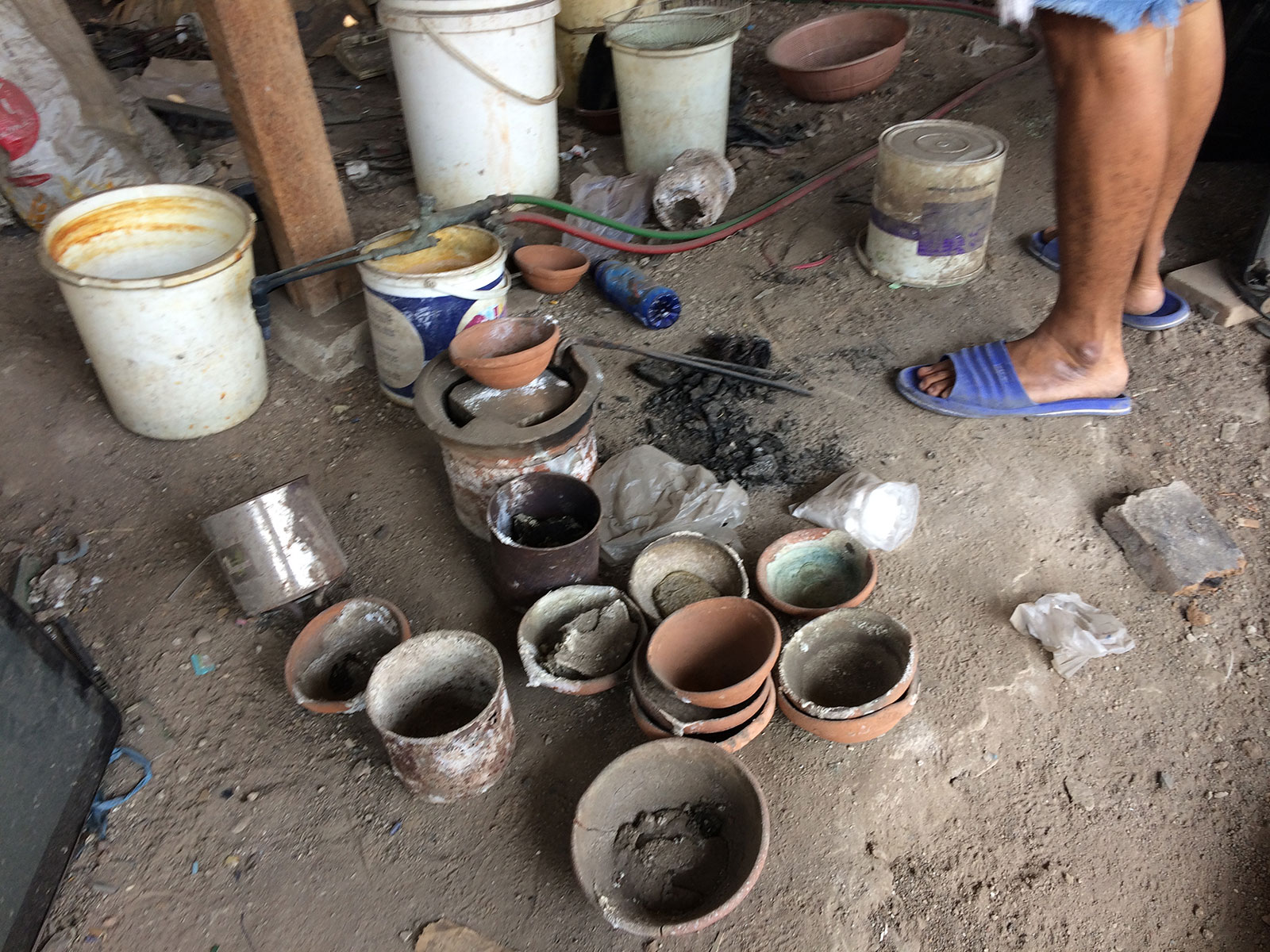

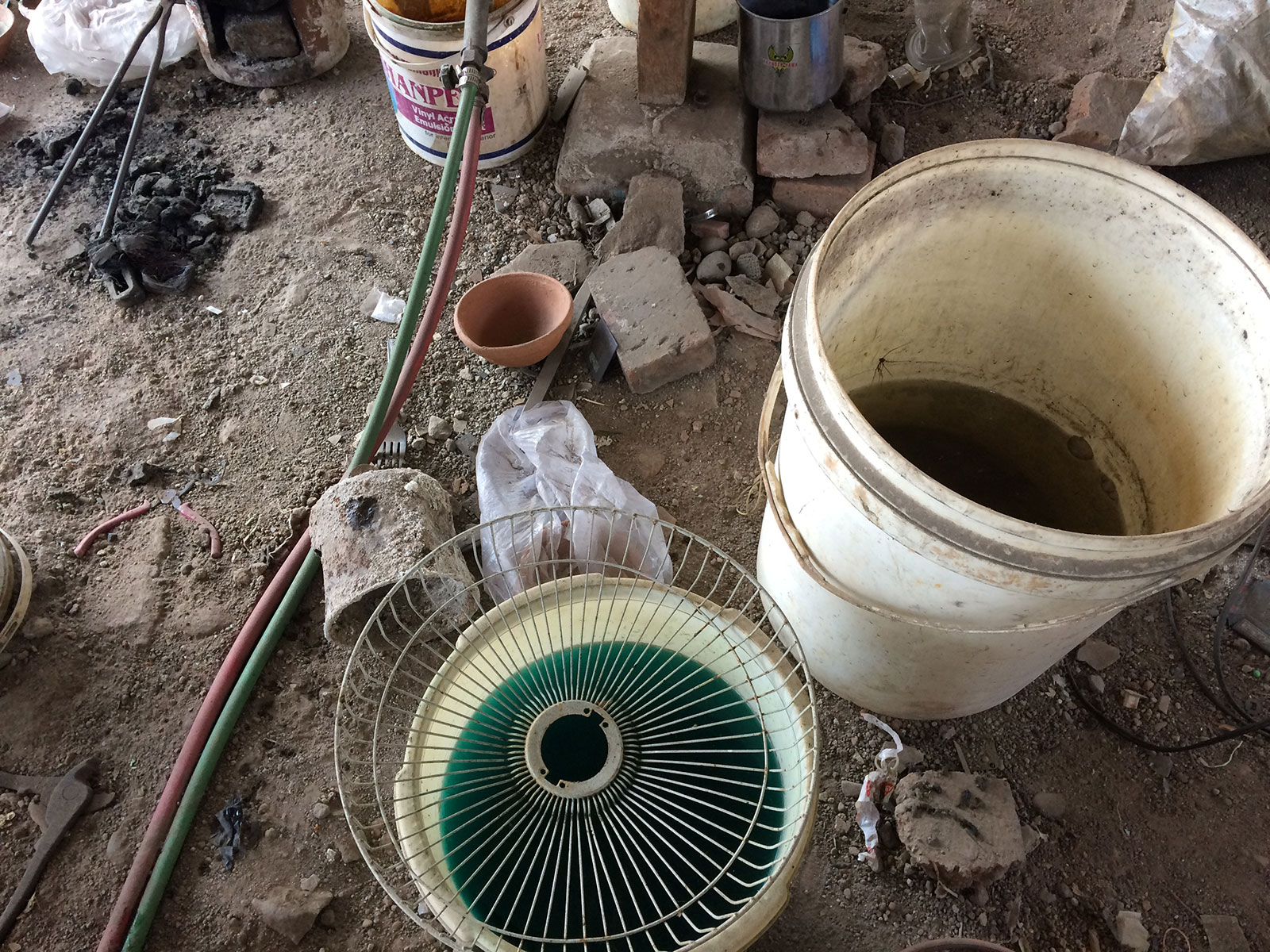
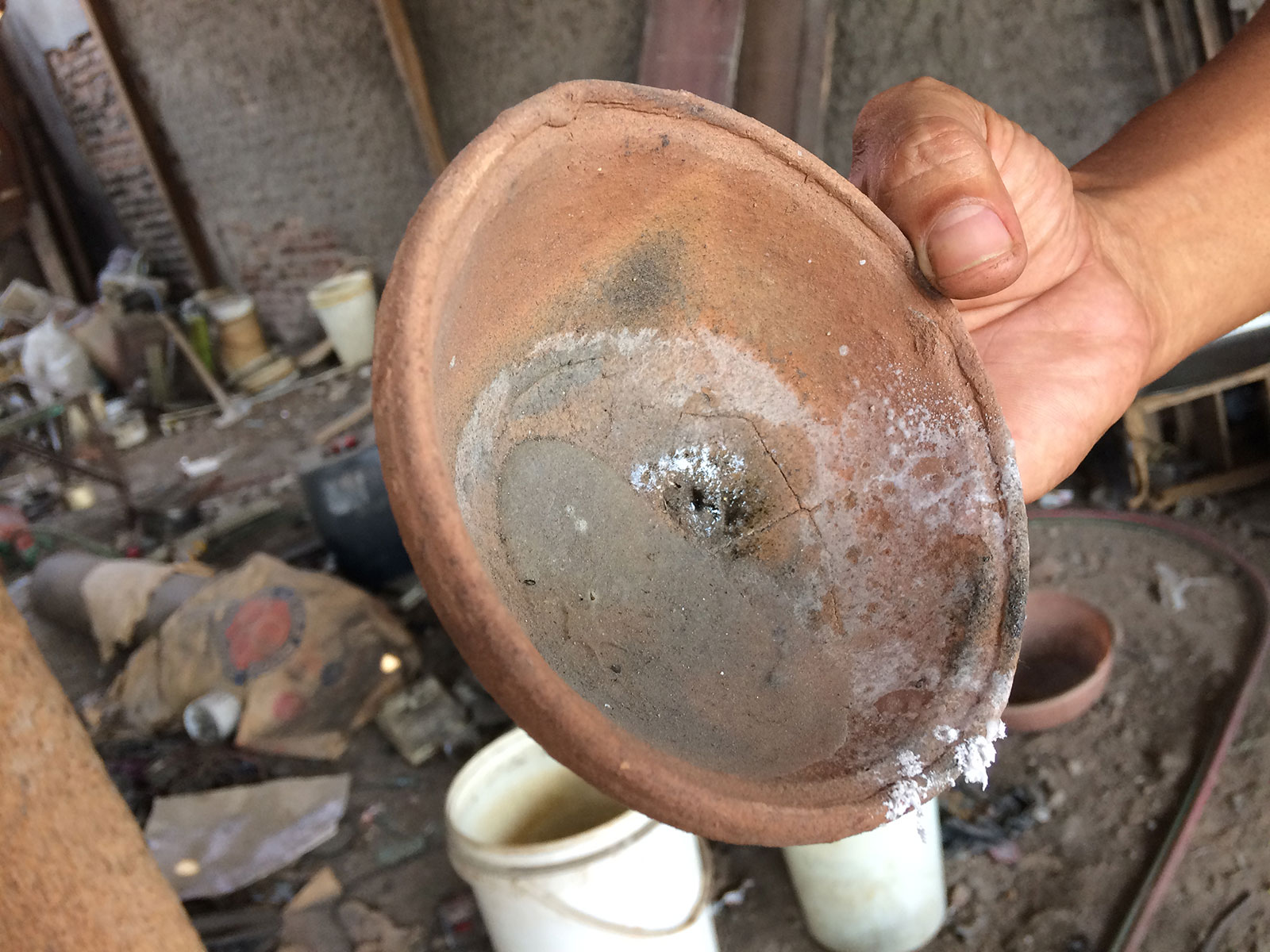
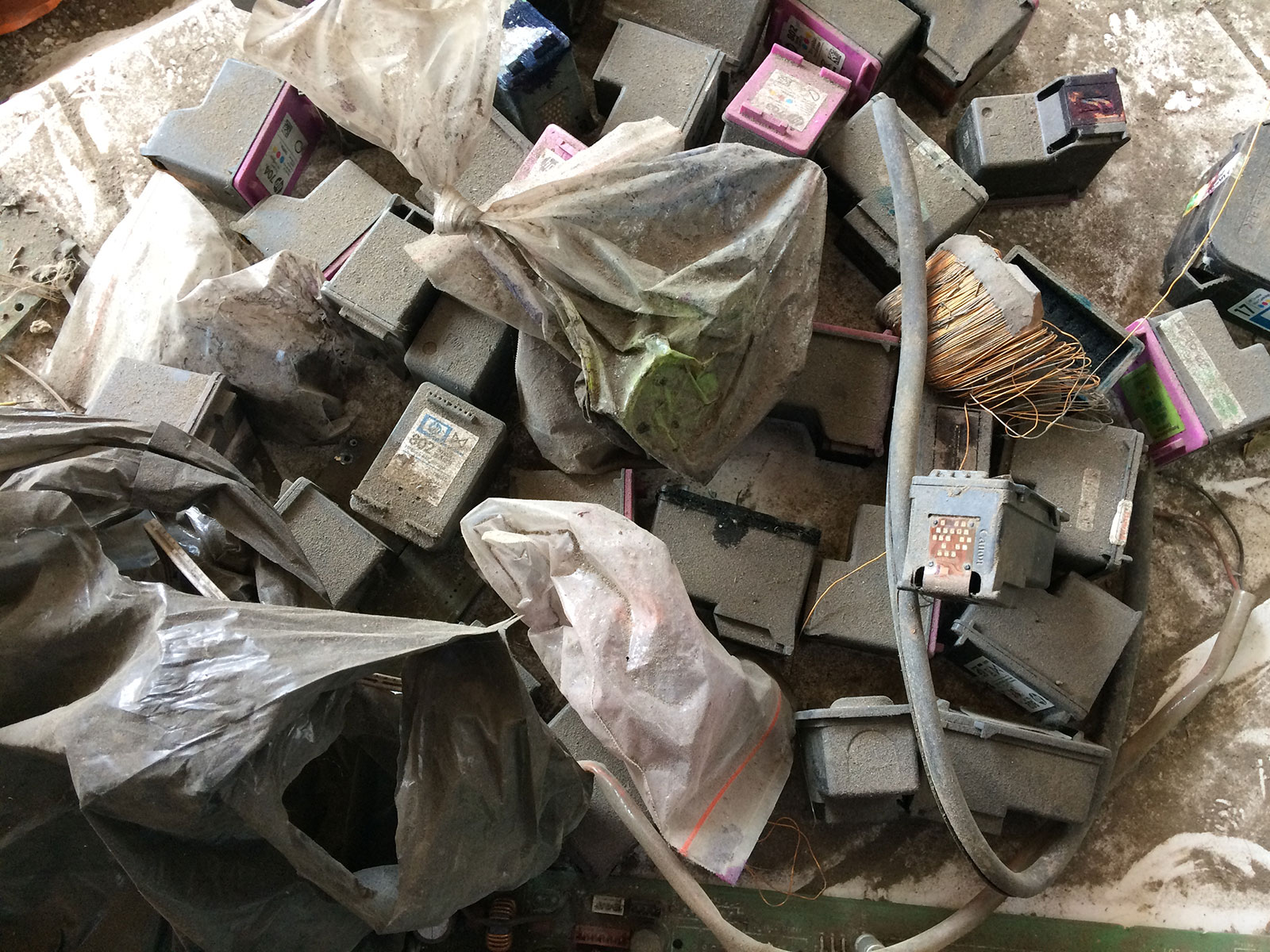

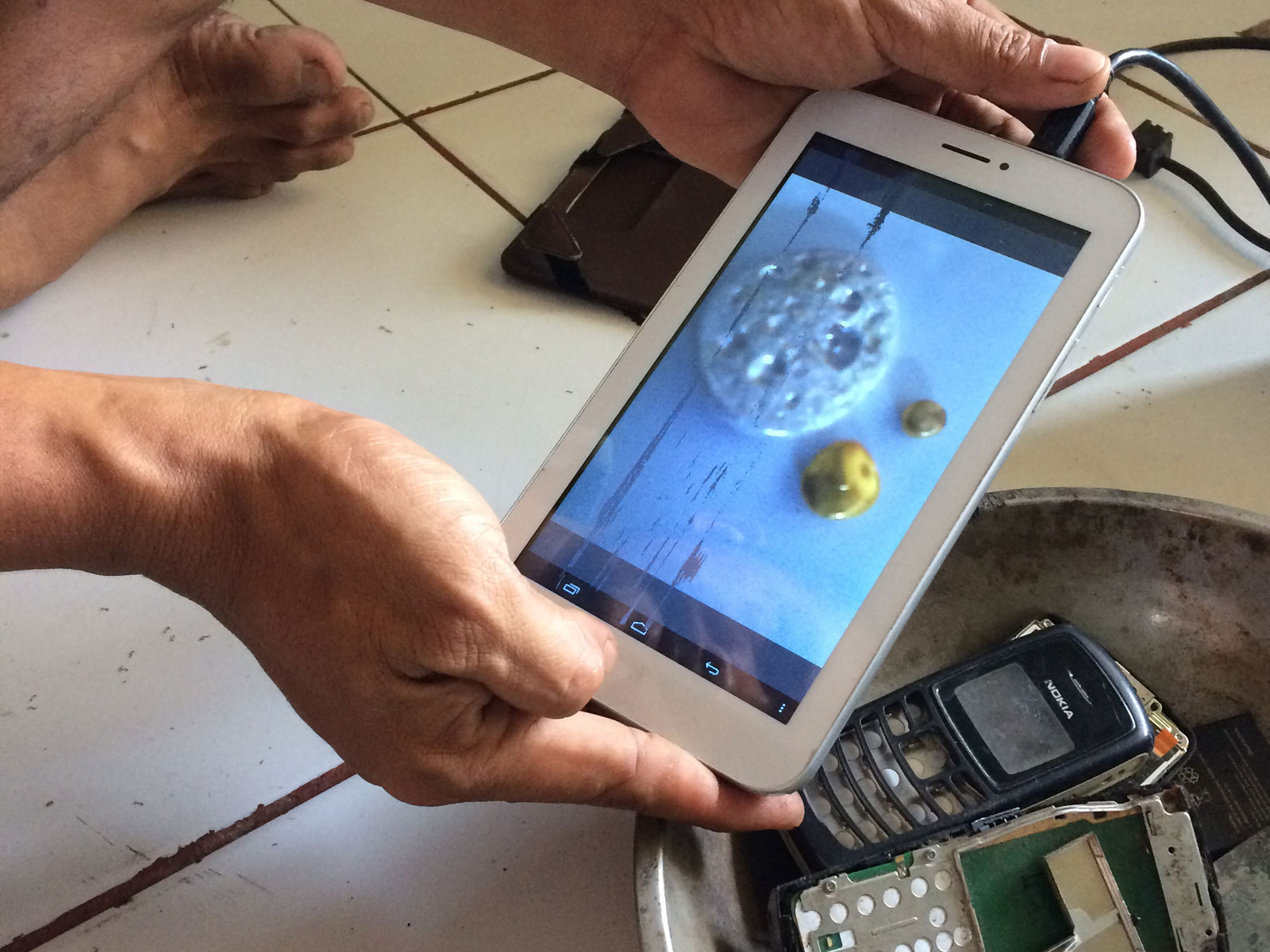
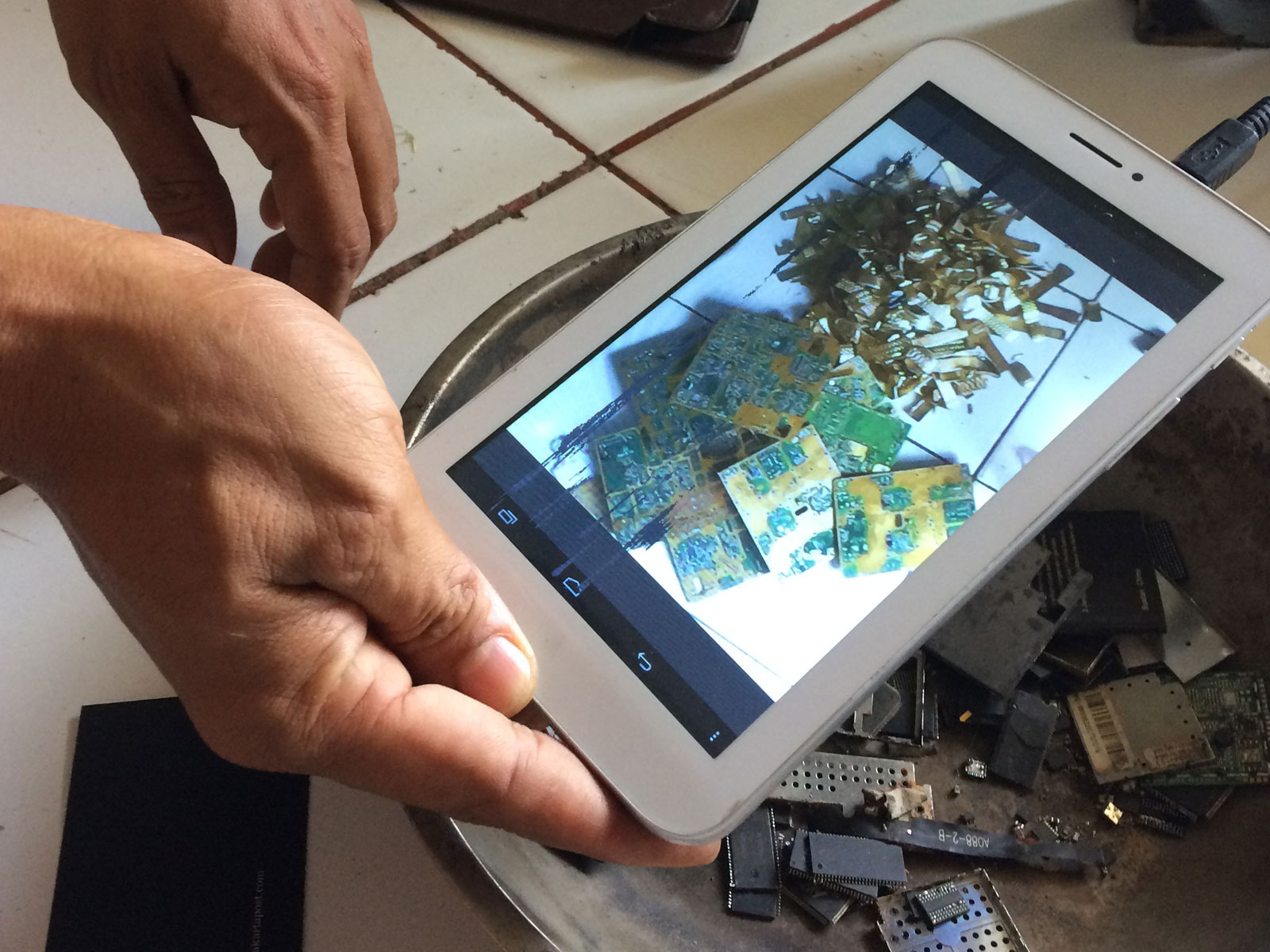


From the outside, there is nothing to suggest that the modest building tucked into a crowded neighborhood in Tangerang, Banten, is a workshop full of high-tech electronic junk (Photos: Corry Elyda)
“I bought this property after my house was no longer big enough to store all these dead devices,” Musa says as he works on a PCB. His house is just across from the workshop.
Musa is but one urban miner – the people who make a living extracting precious metals like gold, silver, lead or copper from discarded electronic waste in Greater Jakarta. Generally, they are ignorant of the dangers that e-waste poses to their health, and neither do they have sound knowledge about the legal aspects of their business.
An electrician by training, Musa started his business in 2011, when the world silver prices skyrocketed. Without any formal education in metals, he learned about e-waste treatment from friends, books and the internet out of simple curiosity.
“I got lots of electronic junk that I couldn’t reuse, so I learned how to make money out of them,” he says.
Basically, he is a self-taught e-waste entrepreneur. He experimented before he eventually “invented” his own method for extracting precious metals from junked electronics.
He regards every part of an electronic device as valuable. When The Jakarta Post visited his workshop, he picked out a PCB of a PlayStation and pointed to the components containing lead and copper. He showed traces of gold in its IC, or integrated circuit.
Musa, who became interested in electricity as a junior high school student, started extracting the metal by dismantling the components. He then smelted them by way of burning. The odor was choking. It’s no wonder that some of his neighbors have lodged a complaint against him, as he admitted with glee.
 Not so remote control: A worker picks up a remote control from a pile of discarded electronic junk. (JP/Seto Wardhana)
Not so remote control: A worker picks up a remote control from a pile of discarded electronic junk. (JP/Seto Wardhana)
His neighbors have good reason to complain about the pollution. Experts say that burning e-waste in the open poses health hazards to the entire neighborhood, because the fumes from burning plastic and other materials can cause cancer. But Musa claims he has invented a trick to lessen the stink, and his neighbors have stopped fussing.
After smelting the components for one to two hours, he adds chemicals that will turn the metal alloy into liquid. The gold settles down as sediment. To distill other metals like silver, he adds other chemicals.
Musa considers the chemical mix as a signature recipe, which he invented through experimenting and will not share with anyone else. But he did not mind spilling the beans a little, saying his base materials included hydrochloric acid (HCl), nitric acid, caustic soda, potassium and sulfuric acid. Most of the substances are hazardous. Nitric acid, for example, is corrosive and a powerful oxidizing agent that can cause severe chemical burns.
Musa says he is well aware of the dangers the chemicals pose but he plays it down, thinking he can overcome it easily. He wears gloves only when he thinks the situation calls for it.
“What I should watch out for is where the wind blows, so I know the position I need to be in to avoid being exposed to the smoke from the chemicals and burning metals.” He has gotten minor burns before, but that did not deter him.
The money that comes from toiling with the e-waste overcomes all the neighbors’ complaints about the stinky smell and the high risk of injury.
He reckons that from every kilogram of IC he buys for Rp 700,000 (US$52), he can extract about 3 grams of gold worth Rp 1,560,000. The much less valuable silver sells for Rp 6,500 per gram.
In the past, when he still had a broker who supplied him with junked electronics, he could extract 10-20 grams of gold every month. “The boss went bankrupt. Now, I rely on the scavengers for e-waste. I usually get only about 5 grams of gold a month now,” says Musa.
 Unnatural selection: A worker sorts through electronic parts at a junk mall in Depok, West Java. (JP/Seto Wardhana)
Unnatural selection: A worker sorts through electronic parts at a junk mall in Depok, West Java. (JP/Seto Wardhana)
His fellow urban miner, 34-year-old Nahrawi, is not as dedicated. These days, he is pondering another business. “The risk just weighs a lot more than the monetary gains,” says Nahrawi.
Nahrawi inherited his urban mining know-how from his in-laws, who made their fortune on gold extracted from chemical waste. They extracted the gold from the chemicals that had been used to polish the precious metal. Nahrawi switched to the e-waste business after the chemical waste became too expensive.
“It took me one-and-a-half years to extract gold and silver from scrapped electronic components,” he said. Still, he does not feel he is good enough at disassembling electronic components for precious metals.
He claims he is able to contain the resulting environmental damage within a 10-meter radius of his house. “None of my neighbors have complained [about the chemical smell],” he said, adding the punchline, “because they are my relatives.”
Urban miners like Musa and Nahrawi have no big competitors, as Indonesia has only a few industrial-scale e-waste companies.
PT Prasadha Pamuna Limbah Industri (PPLI), which partners with the Jakarta administration, for example, specializes in scrapped mobile phones collected from residents.
“It’s a small business […] Extracting metals require complicated bureaucratic procedures and a big investment,” says PPLI spokesperson Arum Tri Pusposari. That explains why small-scale urban miners have the support of environmental groups such as the Committee for the Phasing Out of Leaded Fuel (KPBB), which has offered them free consultation.
“Instead of evicting and criminalizing them, it would be better for the authorities to provide them a place where they can do business together and give them entrepreneurship training and educate them on health and safety standards,” says KPBB executive director Ahmad Syafrudin.
Only by embracing them can the state authorities control their activities and contain the pollution their activities produce, all the while legalizing their entrepreneurial, individual efforts at e-waste management and putting the black market to an end.
| Producer | : | Ika Krismantari |
| Writer | : | Corry Elyda |
| Senior Managing Editor | : | Kornelius Purba |
| Managing Editors | : | Primastuti Handayani, Rendi A. Witular, M. Taufiqurrahman, Damar Harsanto |
| Desk Editors | : | Pandaya, Imanuddin Razak |
| Art & Graphic Design Head | : | Budhi Button |
| Motion Graphic | : | Rian Irawan |
| Photographers | : | P.J.Leo, Seto Wardhana |
| Technology | : | Muhamad Zarkasih, Mustopa, Ega Agung Nugraha |
| Multimedia | : | Bayu Widhiatmoko, I Gede Dharma JS, Ahmad Zamzami, Devina Heriyanto |

